Pomeranians are a small breed of dogs that are descendants of large sled dogs. The history is quite interesting.
Despite its small size, this foxy-faced dog is active and competitive, yet obedient. Poms are good pets, but they bark a lot.
The best thing to do is to let them have lots of playtime and exercise. They cannot endure the hot weather.
Giving them lots of attention and love will make them an adorable family companion.
Complete List of 13 Recognized Colors of Pomeranians
There are 13 varieties of fur coat colors recognized by the American Kennel Club.
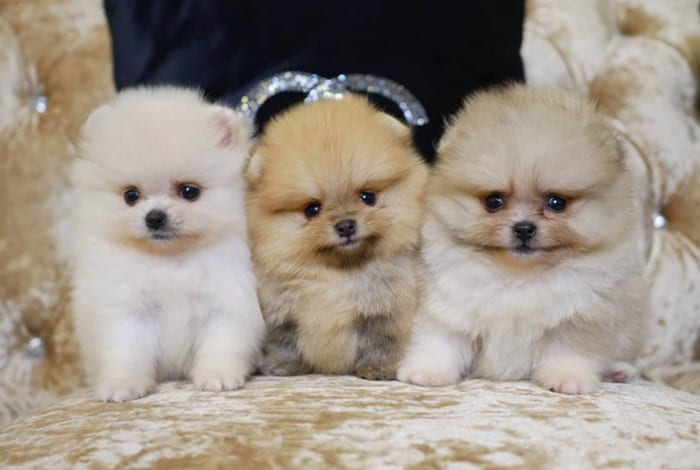
1. Orange
Probably the most popular among the thirteen colors of a Pomeranian. They are the easiest to find.
An orange Pom has some shades of orange ranging from light to dark hues. This color is a product of breeding orange and sable Pomeranian.
This dog gets most of its genetic makeup from the orange Pom parent. That’s why most dog lovers think that Pomeranians come in a single color, which is orange.
2. Red
The red-colored furs appear in deep rusty red color with cream fur in the chest. In most cases, some are confused with red Poms and those with subtle orange fur.
Black and red Pomeranian quite have some similarities because of the E locus gene. Together with orange, they are the two most famous colors of the dog breed.
3. White
The cleanest color of Pomeranians. They do not feature any dark markings. These white-colored fur Pomeranians are born white. They lack dark melanin pigment, which most dogs possess.
But this does not mean that they don’t have albino Pom. Being albino gives their eyes red pigment and nose with a pink hue.
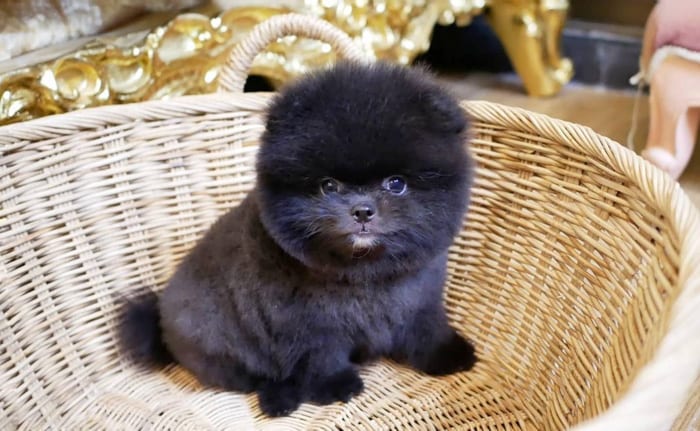
4. Black
The black furs appear in solid black color. It results from the E locus allele gene that increases the black pigment.
However, exposure to sunlight may bleach their solid black furs. So, be very careful when taking them for a park walk or on the beach.
5. Merle
Can be described by the scattering of red pigment in a tan based fur. It also comes with some patches of white.
Merle is a color similar to the Australian Cattle Dog. They usually have a Blue or Red Merle pattern. Their paws have shades of pink.
Their eye colors vary from dark brown to blue. These patterns are produced by breeding a Merle Parent with a Black or a Chocolate Pomeranian.
A double merle bred is very susceptible to blindness. This is caused by the gene that suppresses particular pigment cells found in the eyes’ iris and the cochlea.
6. Wolf Sable
The colored fur is common in gray. It comes with lips, paw pads, and eye rims. Wolf Sable is also called as ‘Gray Sable.’
What makes this breed color interesting is that it has black-tipped guard hairs. The darkest colors can often be found in the face, back, and chest.
The only way you would know if your dog is a wolf sable would be conducting a color gene test.
Gray has considered one of the rare Pomeranian colors that it is incredibly hard to find a purebred one.
7. Chocolate
Appears in literally chocolate color, ranging from milk to dark chocolate. Their nose and paw pads appear in a silky brown color. The color can also be regarded as the color of a liver.
This is because of the B Locus gene that creates a black pigment color. The black pigment mutates and dilutes, which results in a chocolate color.
Just like solid black fur coats, you should not expose them to the sun for too long. The sun can redden their fur and will make it difficult to see the original color.
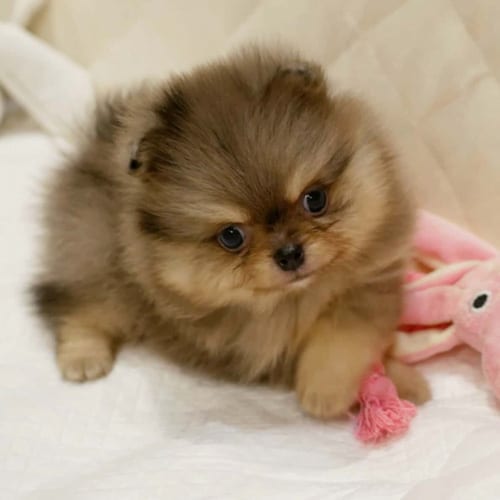
8. Blue
This is a conjoined silver gray and dark gray guard hairs with blue undercoats.
They are bred from two solid colored parents that dilute genes. Sadly, they are prone to some health issues, such as color dilution alopecia.
This health issue dries the skin and results in more frequent shedding. This can lead to hair loss, which could make your Pom look less cute.
9. Cream
Appears in the color of a pale, like a honeycomb. This type of color coat is often born pure white.
But as they age, their fur darkens into the cream hue. This makes it need more frequent grooming as the fur looks more obvious in clothes.
10. Brindle
This pattern shows markings of different colors such as gold, orange, red, and black. Seemingly, its long coats reflect the canvas of the Earth’s layer color tones that are more regarded as a pattern than a color.
The darkest points can include the ears, paws, muzzle, and back. Some can be overpowered by a gray hue or brown. This pattern results from the recessive “ee” in the E Locus genotype involved.
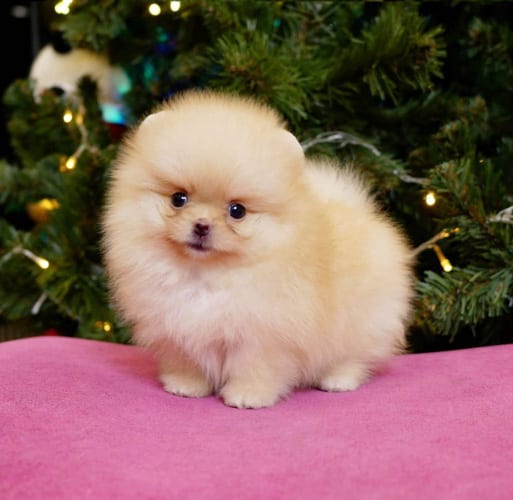
11. Black and Tan Poms
Have tanned chest and legs surrounded by black fur. That’s why they are regarded to be a look-alike of a Rottweiler or a Doberman Pinscher.
Black and Tan Poms have black coats with a few drops of tan hue. They are popular because of a dot above their eyes regarded as eyebrows.
12. Beaver
This is a color used to be known as biscuit as it appears in a pale brown color of a cookie. It comes in a range of variety from brown to beige that is also in gratitude to the dilute gene mutation.
This coat color is the same as Blue Pomeranians. They are also prone to Color Dilution Alopecia that causes dry skin and hair loss.
That’s why it is of utmost importance for you to pick a knowledgeable breeder with safe stock.
13. Tri-colored
Appears in black, tan, and white patterns. These colors are the least popular among the above given.
They can either be white, dark, or a complete blend of all three colors. Their eyebrows look the same as the Black and Tan Pomeranian.
True Black and Lavender Pomeranians are also known to be the rarest colors of the said dog breed.
The True Black Pom does not have any markings. The Lavender Poms feature a gray hue with drops of light purple.
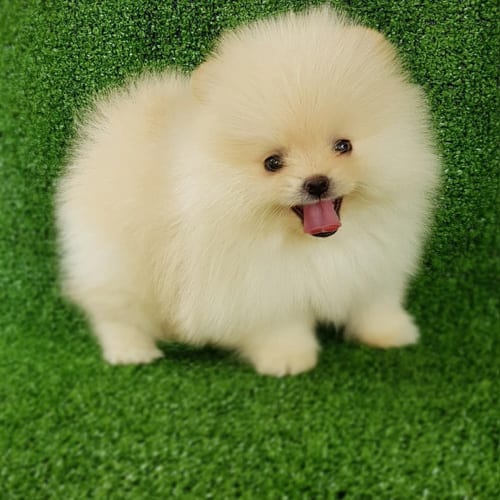
What Is The Rarest Color Of Pomeranian?
This breed of dogs has a diverse color available. But the most common are brown, orange, and white. The black color is a rarely recognized variant of Pomeranians.
They get the black coat from German Spitz, in which Poms inherited most of their genetic makeup.
What makes the black variant rare is because it is difficult to find a pure black Pom.
But breeders are trying to produce black Pomeranians. You can get pure black Pom by breeding two black variants.
Black Pomeranians get hot quickly. That’s why it is not recommended to let them play under the sun for long hours.
Their paws easily burn when walking on hot pavement. Genuine black Poms do not have stripes or patches of another color. Thus, be watchful in determining the real black Pomeranian.
What Is The Most Common Color Of A Pomeranian?
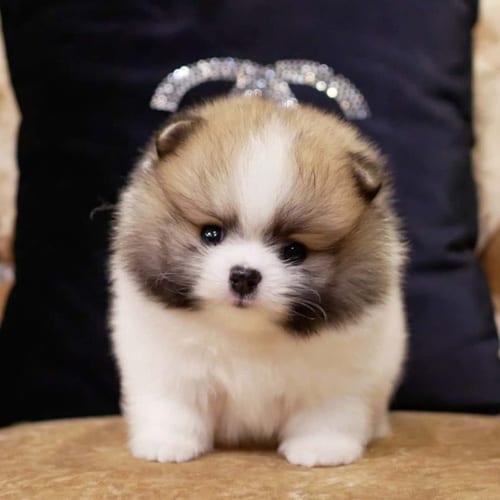
The orange is the most common color among Pomeranians. It has different hues of orange.
You can find light or dark shades. An orange Pom with black stripes is an orange brindle. The one with black tips is an orange sable.
When we say ‘Pomeranians,’ most dog lovers will think of the color of ‘orange.’
Pomeranian breeders call orange Poms ‘clear orange.’ This term differentiates the true orange hue from the orange sable. This color results from breeding a sable with an orange Pomeranian.
Orange-colored Pomeranians are as pale as pups. It requires more proper care than other breeds.
Watching them bloom their actual color and become more mature gives a different level of happiness.
In most cases, a young orange Pom comes in the sable coat. But as they grow older, their coat turns into a clear orange hue.
They do not have any black fur. But they feature a light cream color that comes with a few drops of dark and light orange colors.
Orange is the most recognizable color of a Pomeranian dog that is available in most dog breeding agencies.
What Makes A Pomeranian Expensive?
A Pomeranian or any dog breed’s cost is mostly factored by what they address as the pedigree.
The pedigree determines its blood and family lineage that tells whether a dog is purebred. Another thing is that what occurs to have hardship in producing more Pomeranian.
In some places, it is difficult to look for female Pomeranians. Female Poms have a lesser population than males. The number of their population makes them costly.
Compared to the Pomeranian’s solid coats, the rarest colors, such as blue, lavender, white, and black, are the most expensive.
Teacup Pomeranians with solid coats, such as red, are available from 700 US Dollars to 2,000 US Dollars price range.
The following are some factors that affect the price of a Pomeranian:
- Quality
- Faults and health
- Location
- Coat
- Sex
- Age
The most expensive kind of Pomeranian depends on the rarity of its fur coat color and, of course, it’s pedigree.
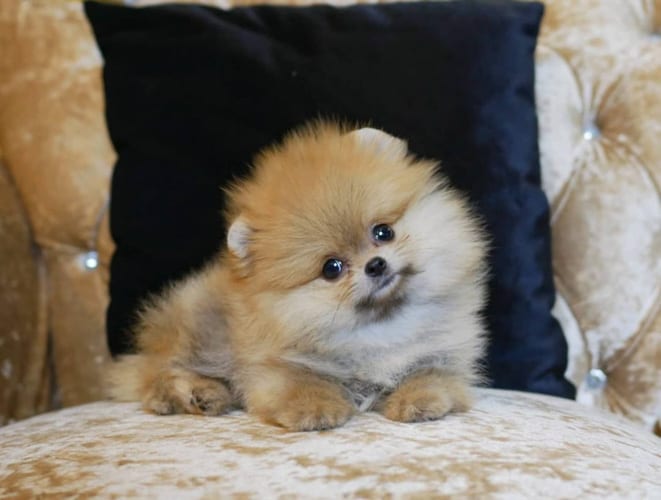
Life Span and Maintenance
Pomeranians live in 12-16 years, and they stop growing at the average age of 12 months.
In taking care of this breed, you must be more conscious of everything they eat. You likewise have to be mindful of the products they use.
The lifespan of a Pomeranian is also affected by how often their grooming session is. Be ready with supplies of shampoo and conditioners best for your dog.
These dogs are a perfect family companion. It is also an ideal furry friend for working adults.
This is because adult Pomeranians do not require more maintenance. But, no matter how busy you are, do not forget to brush their fur at least once a day using a wide-teethed comb.
Are Pomeranians good family dogs?
Despite their sizes, Pomeranians are great night watchers. Their physical attributes could scare night thieves.
This is because they look like a wolf with small stature and little paws. Though they are small, they are aggressive towards strangers and other dogs.
Most PAW parents think that female Poms are the ideal dogs. Compared to the myths of being sweet, female Poms are territorial, hard-headed, and independent.
On the one hand, male Poms are fun-loving, more affectionate, less moody, and attentive.
Their small, upright ears do not lessen their intellectual capability. It makes them more alert during nighttime.
Its neck is covered with fur. This makes them ideal in cold areas, such as Northern Germany and European areas.
Conclusion
Pomeranians are one of the most lovable dog breeds. Like the other breeds, they need extra care and maintenance to grow healthily and happily.
